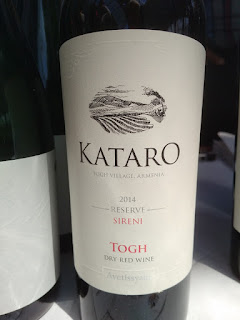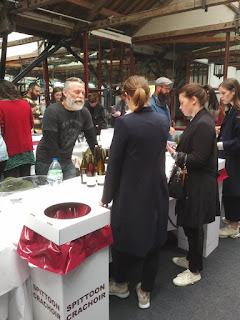The London Wine Fair is quite large by UK standards but much more mainstream than RAW or the Real Wine Fair. There are discoveries to be made though but these are often hidden and require time to be winkled out.
Following our discovery of Armenian wine at ProWein, Duesseldorf a month previously we headed upstairs for the 'Esoterica' section of the London Wine Fair at Olympia which is where smaller agencies and importers are to be found.
 |
| the kind ladies of Armenia Wine Company |
 |
| Armenian Wine Importers Ltd. Founder Charles Masraff is on the left. |
Amazingly there were no less than two Armenian outfits on this mezzanine floor, Wines Unearthed and in 'Esoterica' proper, Armenian Wine Importers Ltd. Just to be complicated there was a third company, Ginvino 'Bringing you the best wines of Armenia' on the ground floor with the big guys.
We started with the Armenia Wine company but their grapes - Areni, Voskeat etc. were already familiar to us so the kind ladies there directed us to Armenian Wine Importers just around the corner. There we met Charles Masraff and his colleague. Charles is half Armenian and lived in Yerevan for a number of years. Comparatively recently he founded this company and is importing a handful of interesting wines.
One of these, Kataro is from Khndogni - a grape found mainly in Nagorno-Karabakh and used in Armenia, Uzbekistan, Iran and Russia where it is also called Scireni. Producers now favour the name Sireni as an easier one to use and so do we especially as there are other Armenian grapes beginning with the letter K such as Kangun and Karmrahyut not to mention lots of Georgians, Ukrainians and others beginning with the same letter. The only fly in the ointment is that the most famous Armenian red variety is Areni - a possible point for confusion with Sireni?
 |
| Togh is the Reserve version of Kataro's Sireni. |
there were also reds from Areni, a white from Voskehat and a sparkling wine from a grape called Khatoun Kharji (60%) and Voskehat (40%) from a producer called Keush.
Khatoun Kharji has yet to be included in 'Wine Grapes' but it may be found in Galet.
 |
| Founder of Ginvino (right) with clients |
Ginvino is the unlikely name of another Armenian wine company this time London based whose stall on the ground floor sported an evocative amphora (called Karas in Armenian). Ginvino import Van Ardi wines among others.
Close perusal of the catalogue after the event turned up some fascinating gems we wish we had discovered at the time.
One of these was Fekete Járdovány to be found at the Wines of Hungary stand. The producer, our friend Gere, describes the grape as follows;
Fekete (literally black) is a grape variety unknown for even local wine experts. It is practically not grown anywhere, Attila Gere, the iconic winemaker in Villány however has a tiny vineyard of this ancient grape of the Carpathian Basin. He carries on several experiments with the research centre of Pécs, and his single varietal Fekete Járdovány is a result of this experiment. The grape extincted with phylloxera, but it came to life again in 2011, when the first vintage was made. The 2014 vintage of the 100% Fekete Járdovány has just been released. The wine was aged for 6 months in barrique, and available in limited quantity. Light, fruity wine with a nose of sour cherry and rose pepper. On the palate it is easy going, lovely and spicy – slightly similar to Kadarka.
There were other unusual varieties among the Hungarians. Generosa is an Ezerjo x Savagnin Rose (Roter Veltliner) cross obtained in 1951 and released in 2004. It just shows what a long gestation these varieties have between discovery and full production.
Kabar, another new one on us - is destined for the production of Tokay. Bouvier and Harslevelu are the parent grapes.
This rose is from Menoir which we like very much as a red wine. Attempts to link Menoir/Medoc Noir/Kekmedoc to French varieties such as Mornen Noir, Cot/Malbec or anything else seem to be doomed and Menoir looks like a native Hungarian variety.
the following is a list of goodies taken from both the LWF and Esoterica guides;
Evmolpia. A recent Mavrud x Merlot cross from Bulgaria. Vaskovino specialises in sugn Bulgarian grapes.
Moscatel Tinto (or Negro) is Mission/Pais/Listan Negro. Las Bodegas had a wine from Argentina with this name for the grape involved.
Morenillo is in Galet but not 'Wine Grapes'. It is also known as Barillol. Georges Barbier had a wine from Catalonis including this grape and Garnatxa Tinta.
Arbois is a synonym for Menu Pinot. Amanda's Loire Valley Wines had two wines of Arbois.
Ethical Edibles had a Vino Nobile di Montepulciano with Mammolo listed as No. 1 in a blend including Canaiolo and Prunolo Gentile. This is our first sighting of Mammolo in any wine. They also had a Bianchetta Genovese which is difficult to find outside Genova.
If you like Juhfark, Witness Mountain Ltd seem to be the people to contact. They had 5 versions on show.
Maltby and Greek is known for their Greek wines but Southern Wine Roads is no less active with over 35 indiginous Greek varieties including the rare Katsano, Gaidouria and Zakinthino.
We also read - too late - that we had missed not one, not two but three Belgian producers. That was a real pity. it just shows the importance of preparation for these events.
 |
| Salena Franchitti after whom the estate is named |
One exhibitor for whom we were prepared was Salena Estate Winery of South Australia.
Ever since Darby Higgs gave us a bottle of Salena's Bianco D'Alessano we have been huge admirers of this winery.
They also make Montepulciano,
 |
| Touriga, Lagrein and Cabernet |
 |
| the blend varies from vintage to vintage |
Touriga Nacional, Lagrein, Sangiovese, Graciano, Tempranillo, Vermentino, Riesling and Moscato as well as the more usual Shiraz, Cabernet Sauvignon, Petit Verdot, Chardonnay, Semillon, Sauvignon etc.
The estate is over 200 acres and produce organic wines, bulk wines, own label wines and ptivate label wines
John Thorne is Salena's UK representative. His company also represents a Champagne house and an English Sparkling wine estate, Sixteen Ridges. John is not only very effective - you can buy Salena Estate wines at Oddbins - he is a very amiable and kind person who arranged for us to obtain a case of Salena's Bianco D'Alessano without paying a fortune in shipping charges.


















































